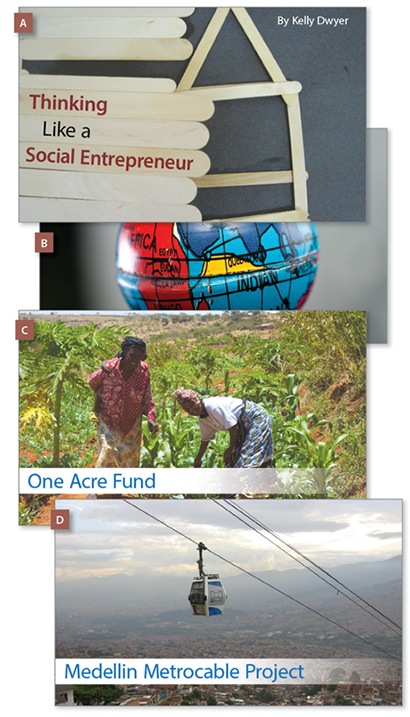Web Page: Pecha Kucha Frequently Asked Questions
Web Page: Pecha Kucha Watch
Web Page: Pecha Kucha Global
Each presentation is exactly 6 minutes and 40 seconds long.
The slide show must include 20 slides.
Each slide is displayed for exactly 20 seconds.
The following is a portion of the script for a Pecha Kucha presentation prepared by a student for her economics class. The next page displays some of the slides that accompany the presentation.
Thinking Like a Social Entrepreneur
The beginning introduces the speaker and engages the audience with a unique story that leads them to the thesis.
(Slide 1) My name is Kelly Dwyer, and I ate a lot of Popsicles as a child. When I was eight, I used the leftover sticks to build a guesthouse for my dolls. It had a roof, a chimney, and windows. It was awesome. Then I had an epiphany. My neighborhood didn’t have a playground or park nearby, so I planned to collect everyone’s Popsicle sticks and build a huge playhouse for all the neighborhood kids to use. (Slide 2)
Of course, I soon realized this plan was ridiculous. Today, I’m not so sure. It was a logistical nightmare, yes, but my intentions were spot on. I wanted to solve a big neighborhood problem.
The parenthetical notes indicate each slide change.
I believe we all should begin thinking like social entrepreneurs. (Slide 3) Social entrepreneurship is the process of identifying a pressing social problem and using problem-solving skills and a keen business sense to make the problem go away.
The middle slides share examples that support the topic and thesis.
Andrew Youn thought big with his One Acre Fund. He believed he could solve poverty and hunger in Rwanda and Kenya, so he quit his job at a Fortune 500 company and developed a business to empower East African farmers. (Slide 4) The One Acre Fund connects African farmers, educates them on farming techniques, provides up-front capital for supplies and materials, and helps farmers negotiate with export markets. The One Acre Fund now serves 75,000 farmers, each of whom has seen profits soar by an average of 100 percent (“Performance Reports”).
(Slide 5) Social entrepreneurship has also visited Medellin, Colombia. Medellin is a crowded city situated in a large mountain valley. Living on the hillsides are some of the city’s poorest residents, isolated from the jobs and markets of the central city. But in 2004, an idea to connect the hillside communities to downtown turned into a unique public transportation system. (Slide 6) The ending (not included) leaves the audience with a memorable last thought. The city implemented a ski-lift-like cable car between the hills and downtown. Travel time to the city’s center went from hours to minutes. Adults had better access to jobs, children better access to libraries and parks. Crime rates plummeted (Chu).
A Slide 1: The first slide includes the title and author of the presentation.
B Slide 2
C Slide 3: The middle slides show compelling images with limited text.
D Slide 4
Pecha Kucha presentations are fast paced and timed, which separates them from other slide shows and speeches. They are also more casual than other presentation formats. A Pecha Kucha presentation is like an open-mic night at a coffeehouse. The presenter needs to engage and hold the audience. As you begin to work on your own presentation, remember these additional tips:
Your Turn Prepare a Pecha Kucha presentation following the tips above and the guidelines on the previous pages.
Web Page: Pecha Kucha Frequently Asked Questions
Web Page: Pecha Kucha Watch
Web Page: Pecha Kucha Global
© 2014 Thoughtful Learning
